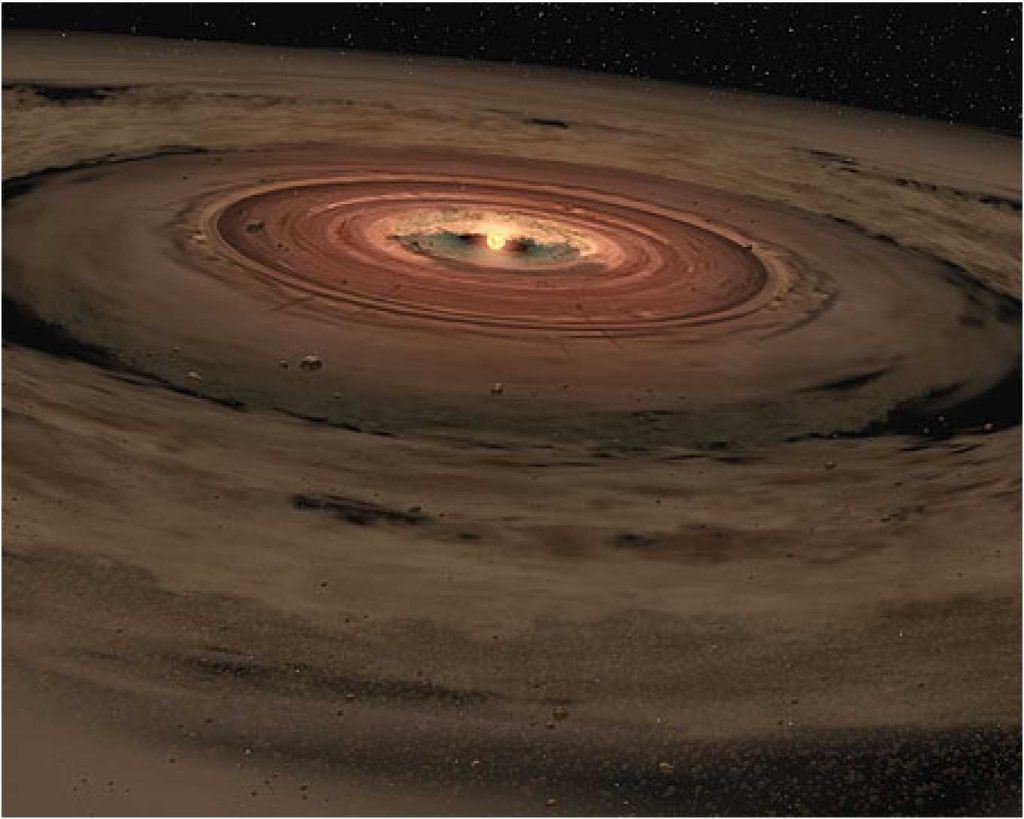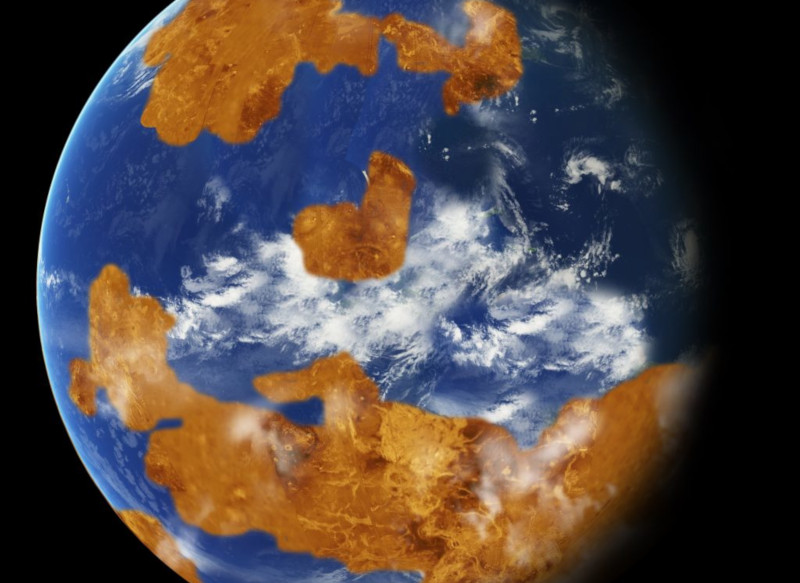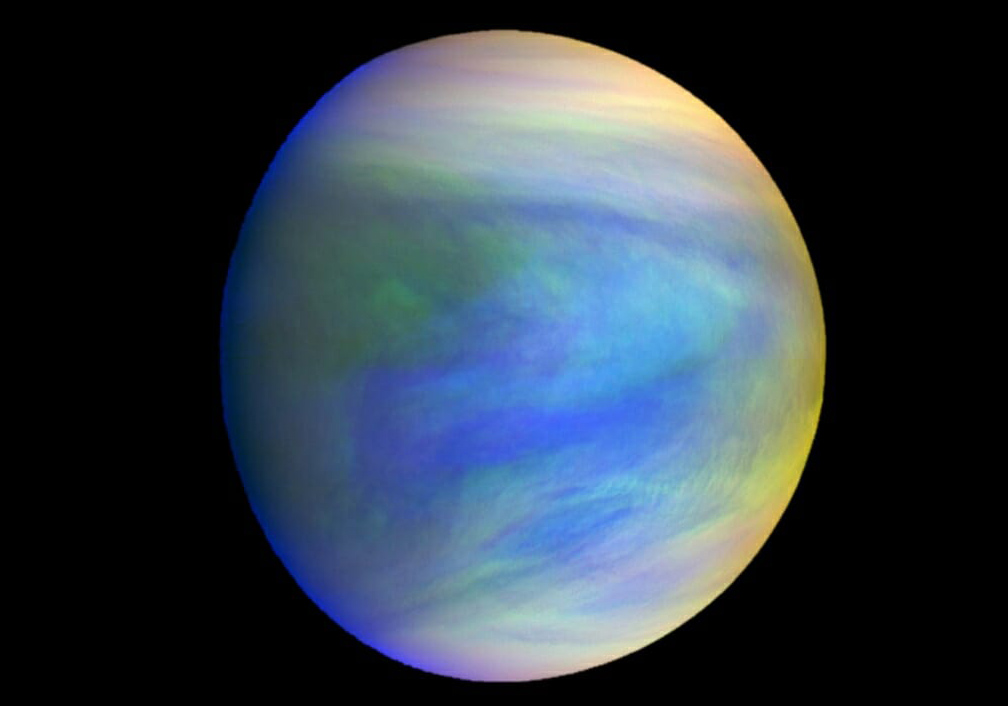Formation
According to what we know, Venus must have formed like Earth, by acression of elements of the protoplanetary disk. One would therefore think that the two planets were identical to the origin, which makes their divergence all the more incomprehensible. The first of these puzzles is the speed of rotation. The protoplanetary disk rotated in a prograde direction, so that six of the eight planets and the majority of their moons rotate in the prograde direction around their axis. The two exceptions are Uranus which is lying in its orbit and Venus which slowly rotates in the retrograde direction. It is not known where this sense of rotation comes from, the hypothesis of a large impact is not supported by any evidence. Nor is there a model in which an atmosphere, even as massive as Venus’s, can completely stop a planet and make it go the other way. In addition, during the 60-year exploration of Venus, variations in rotational speed were observed. Variations over such a short period of time (from an astronomical point of view) suggest that the process of changing the speed of rotation is unstable and still ongoing.

It is assumed that the protoplaneal disk was relatively homogeneous and given their proximity, the Earth and Venus had to be made up of the same elements. The deep structure should therefore be close with a nucleus made up of heavy and radioactive elements. But the rotation of the nucleus causes a strong magnetic field on Earth that has no or no more equivalent on Venus. It is therefore not known whether there is a solid or liquid nucleus, and whether it is still or has been rotating. In addition, the heat generated by the nucleus causes movements of the liquid mantle that cause the crust to move to the surface according to the tectonic model of the Earth’s plates. But there is no plate tectonics on Venus and the little volcanic activity detected is too small to drain heat from a planetary nucleus similar to earth’s. At this time, it is not known whether the heat was evacuating during resurfacing episodes, by conduction through the crust or whether the heart went out for an unknown reason. In order to decide, it would require sismographic studies, monitoring of crustal deformations and chemical analysis on the surface. It could also be used to study surface oxidation, because given the pressure and temperature the CO2 should have reacted more intensely with the rocks.
Habitability
With the only example of terrestrial life, it is impossible to conclude whether biology based on the complex chemistry of carbon is the only possible one, or if there are forms so different that they could live in environments that would be hostile even to extremists. The theme of habitability is therefore deliberately limited here to environments that can shelter life as we know it on Earth.
If the surface is analysed, it will also be necessary to look for traces of past presence of liquid water. Indeed, if the planet has formed well as we think, it should have recovered large amounts of water during the accretion phase and by cometary bombardment. This water had to be liquid at first, forming oceans whose surface area and depth are to be determined. It is therefore necessary to confirm this presence of past water and determine the quantity of it. We must therefore look for hydrated rocks especially in teserra (the oldest lands still exposed) or sedimentary deposits due to the flow of water.

A small part of this water is still present in the atmosphere in the form of sulphuric acid within the clouds, but the vast majority has disappeared, it remains to be seen how. Today, the most commonly accepted hypothesis is that it disappeared by atmospheric loss. The water would be reassembled in the upper layers of the atmosphere where it would have been dissociated into oxygen that would have formed CO2 and hydrogen blown by the solar winds. However, a recent planetary evolution model (September 2019) suggests that the planet was habitable only 750 million years ago and it is unlikely that entire oceans could have been blown out in such a short time. It is therefore important to study the traces of liquid water on the surface to estimate the amount of liquid water on the surface and to analyze atmospheric losses to deduce the flow. This is not only essential for understanding Venus but also for having a second model of planetary development of Earth-sized stars to see how it applies to exoplanets. Much closer to our daily concerns, the study of the phenomenon that made Venus uninhabitable is important to understand whether this phenomenon can reproduce on Earth and how it could possibly be avoided.
Atmosphere
Venus’ atmosphere is unique in the solar system because of its size. The behaviour of a low-density atmosphere is known to a pressure of 1bar through the study of the Earth. But on Venus, it’s as if instead of colliding with the surface, this atmosphere relies on 50km of additional air with a high pressure and temperature. By sliding on this lower layer, the cloud area is super-rotating, 50 times faster from the surface. Above, at an altitude of 100km, the behaviour is even stranger, as the air from the centre of the day face moves towards the centre of the night face. Finally, still above, in the thermosphere, the circulation of the atmosphere again follows the super-rotation regime. There is currently no certainty about the nature of the force that drives such a massive atmosphere to move and maintain it.
It is assumed that this rotation is related to the sun, but it is not known if this is due to its gravitational or thermal influence. But to learn more about this thermal influence, we need to refine our radiative balance models. The radiative balance is the amount of energy received and returned by a planet. For Venus, the current models are not satisfactory because they do not allow us to describe what we are observing. There is also a need to better understand how heat circulates in the “oceans” of critical CO2 on the surface or reflectivity within clouds and lower fog layers.

There is also an element in the upper layers of the atmosphere that can have a significant impact on the radiative balance. This element was discovered by orbiters that observed absorption spots in the ultraviolet spectrum that could extend to the visible. These spots evolve in size and time at a rate that corresponds to no satisfactory pattern. Our ignorance of these origins led him to be known in the scientific community simply as the “unknown absorber“. For now, the majority hypothesis is a series of components of sulfur and/or chlorine that would evolve according to a cycle that has yet to be determined. Another, more exciting hypothesis is that these spots are due to a biological process. Bacteria that can withstand acid and absorb UV rays are known on Earth. One can well imagine that if life developed during the habitable period, it would have migrated during the evaporation of water and then adapted to the acidic environment. Even unlikely, this discovery of life would upset humanity’s view of its place in the universe. Indeed, with the one and only earthly example, it is impossible to estimate the density of life in the universe. Some people think that we are the only occurrence, while others think that it is everywhere possible. The discovery of life so close to us, in such a different environment, would greatly tip the balance on the second side.